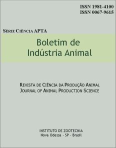Estimation of the potential supply of nitrogen by tropical legumes. II. Region of Itapetininga, São Paulo, Brazil
Abstract
The present experiment was carried out in the field at Posto de Ovinos e Caprinos do Instituto de Zootecnia. in itapetininga, of São Paulo, BraziI. It was evaluated the potencial supply of nitrogen through perenniaI soybean (Glycine wightii Verde.), galáxia (Galactia striata Jacq.). green leaf desmodium (Desmodium intortum cv. Green Leaf Urb.) to Setaria anceps Stapf ex Massey cv. Nandi. Theses species were fertilized with three levels of nitrogen (0, 150 and 300kg per hectare per year) and each one of the legumes was also mixed with the grass. Setaria mixed with perennial soybean, with galaxia and with desmodium showed dry matter yields equivalent to a fertilization of 124. 117 and 105kg of nitrogen/hectare/year on the grass alone. The forage production of the grass alone increased up to 300kg N per year, with increases in dry matter yield (D.M.) of 23.35kg of D.M./kg of applied N and 32% rate of nitrogen recovery. The forage legumes increased the protein contents of mixed Setaria grass compared with Setaria grass alone not fertilized with mineral N. The apparent nitrogen transfer of perennial soybean, galaxia and desmodium to the mixed setaria was 32, 38 and 32.5kg of N/hectare/year, respectively.Downloads
Downloads
Published
Issue
Section
License
Os autores não serão remunerados pela publicação de trabalhos, pois devem abrir mão de seus direitos autorais em favor deste periódico. Por outro lado, os autores ficam autorizados a publicar seus artigos, simultaneamente, em repositórios da instituição de sua origem, desde que citada a fonte da publicação original seja Boletim de Indústria Animal. A revista se reserva o direito de efetuar, nos originais, alterações de ordem normativa, ortográfica e gramatical, com vistas a manter o padrão culto da língua e a credibilidade do veículo. Respeitará, no entanto, o estilo de escrever dos autores. Alterações, correções ou sugestões de ordem conceitual serão encaminhadas aos autores, quando necessário. Nesses casos, os artigos, depois de adequados, deverão ser submetidos a nova apreciação. As opiniões emitidas pelos autores dos artigos são de sua exclusiva responsabilidade. Todo o conteúdo deste periódico, exceto onde está identificado, está licenciado sob a Licença Creative Commons Attribution (CC-BY-NC). A condição BY implica que os licenciados podem copiar, distribuir, exibir e executar a obra e fazer trabalhos derivados com base em que só se dão o autor ou licenciante os créditos na forma especificada por estes. A cláusula NC significa que os licenciados podem copiar, distribuir, exibir e executar a obra e fazer trabalhos derivados com base apenas para fins não comerciais.













